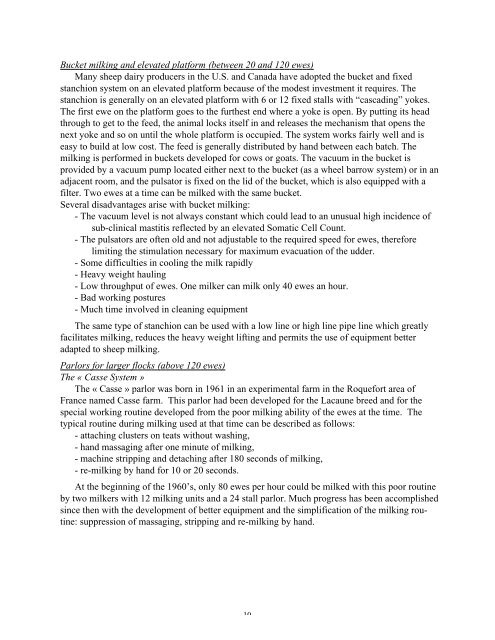Dairy Sheep Symposium - the Department of Animal Sciences ...
Dairy Sheep Symposium - the Department of Animal Sciences ...
Dairy Sheep Symposium - the Department of Animal Sciences ...
You also want an ePaper? Increase the reach of your titles
YUMPU automatically turns print PDFs into web optimized ePapers that Google loves.
Bucket milking and elevated platform (between 20 and 120 ewes)<br />
Many sheep dairy producers in <strong>the</strong> U.S. and Canada have adopted <strong>the</strong> bucket and fixed<br />
stanchion system on an elevated platform because <strong>of</strong> <strong>the</strong> modest investment it requires. The<br />
stanchion is generally on an elevated platform with 6 or 12 fixed stalls with “cascading” yokes.<br />
The first ewe on <strong>the</strong> platform goes to <strong>the</strong> fur<strong>the</strong>st end where a yoke is open. By putting its head<br />
through to get to <strong>the</strong> feed, <strong>the</strong> animal locks itself in and releases <strong>the</strong> mechanism that opens <strong>the</strong><br />
next yoke and so on until <strong>the</strong> whole platform is occupied. The system works fairly well and is<br />
easy to build at low cost. The feed is generally distributed by hand between each batch. The<br />
milking is performed in buckets developed for cows or goats. The vacuum in <strong>the</strong> bucket is<br />
provided by a vacuum pump located ei<strong>the</strong>r next to <strong>the</strong> bucket (as a wheel barrow system) or in an<br />
adjacent room, and <strong>the</strong> pulsator is fixed on <strong>the</strong> lid <strong>of</strong> <strong>the</strong> bucket, which is also equipped with a<br />
filter. Two ewes at a time can be milked with <strong>the</strong> same bucket.<br />
Several disadvantages arise with bucket milking:<br />
- The vacuum level is not always constant which could lead to an unusual high incidence <strong>of</strong><br />
sub-clinical mastitis reflected by an elevated Somatic Cell Count.<br />
- The pulsators are <strong>of</strong>ten old and not adjustable to <strong>the</strong> required speed for ewes, <strong>the</strong>refore<br />
limiting <strong>the</strong> stimulation necessary for maximum evacuation <strong>of</strong> <strong>the</strong> udder.<br />
- Some difficulties in cooling <strong>the</strong> milk rapidly<br />
- Heavy weight hauling<br />
- Low throughput <strong>of</strong> ewes. One milker can milk only 40 ewes an hour.<br />
- Bad working postures<br />
- Much time involved in cleaning equipment<br />
The same type <strong>of</strong> stanchion can be used with a low line or high line pipe line which greatly<br />
facilitates milking, reduces <strong>the</strong> heavy weight lifting and permits <strong>the</strong> use <strong>of</strong> equipment better<br />
adapted to sheep milking.<br />
Parlors for larger flocks (above 120 ewes)<br />
The « Casse System »<br />
The « Casse » parlor was born in 1961 in an experimental farm in <strong>the</strong> Roquefort area <strong>of</strong><br />
France named Casse farm. This parlor had been developed for <strong>the</strong> Lacaune breed and for <strong>the</strong><br />
special working routine developed from <strong>the</strong> poor milking ability <strong>of</strong> <strong>the</strong> ewes at <strong>the</strong> time. The<br />
typical routine during milking used at that time can be described as follows:<br />
- attaching clusters on teats without washing,<br />
- hand massaging after one minute <strong>of</strong> milking,<br />
- machine stripping and detaching after 180 seconds <strong>of</strong> milking,<br />
- re-milking by hand for 10 or 20 seconds.<br />
At <strong>the</strong> beginning <strong>of</strong> <strong>the</strong> 1960’s, only 80 ewes per hour could be milked with this poor routine<br />
by two milkers with 12 milking units and a 24 stall parlor. Much progress has been accomplished<br />
since <strong>the</strong>n with <strong>the</strong> development <strong>of</strong> better equipment and <strong>the</strong> simplification <strong>of</strong> <strong>the</strong> milking routine:<br />
suppression <strong>of</strong> massaging, stripping and re-milking by hand.<br />
10
















